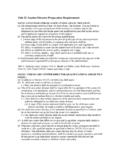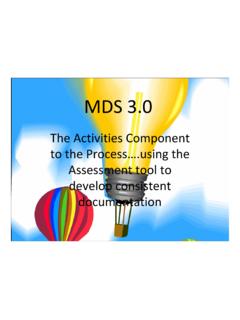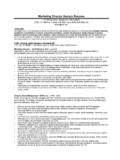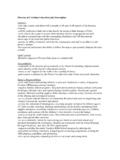Transcription of DEPARTMENT OF LICENSING AND REGULATORY …
1 1 MIOSHA-STD-1301 (10/15) 6 Pages For further information Ph: 517-284-7740 DEPARTMENT OF LICENSING AND REGULATORY AFFAIRS DIRECTOR'S OFFICE CONSTRUCTION SAFETY STANDARDS Filed with the Secretary of State on February 26, 1965, (as amended February 14, 1974) (as amended August 31, 1976) (as amended May 17, 1983) (as amended July 24, 1995) (as amended September 3, 1996) (as amended July 30, 2002) (as amended March 14, 2013) (as amended February 24, 2015) (as amended October 28, 2015) These rules become effective immediately upon filing with the Secretary of State unless adopted under section 33, 44, or 45a(6) of 1969 PA 306. Rules adopted under these sections become effective 7 days after filing with the Secretary of State. (By authority conferred on the director of the DEPARTMENT of LICENSING and REGULATORY affairs by sections 19 and 21 of 1974 PA 154, and Executive Reorganization Order Nos.)
2 1996-2, 2003-1, 2008-4, and 2011-4, MCL , , , and ) R , R , R , and R , are amended and R is rescinded, to the Michigan Administrative Code, as follows: PART 1. GENERAL RULES Table of Contents:R Scope.. 1 R Definitions.. 1 R Adopted and referenced standards.. 2 R Employer responsibilities; accident prevention program.. 2 R Employer responsibilities generally.. 3 R Employee responsibilities.. 3 R Housekeeping and disposal of waste materials.. 3 R Work in hazardous spaces.. 3 R Boilers and pressure vessels.. 3 R Guarding, belts, gears, pulleys, sprockets, and moving parts.. 4 R Machine installations and guarding.. 4 R Sanitation.. 4 R Toilets at construction sites.. 4 R General sanitation.. 4 R Food handling.. 5 R Medical services and first aid.. 5 R Illumination.. 5 R Temporary sleeping quarters.. 5 R Scope. Rule 101. (1) This standard sets forth general rules for the safe use, operation, and maintenance of equipment, and for safe work practices pertaining to all employers and employees performing construction operations, except that where a specific rule is set forth in another part, the general rule is preempted.
3 (2) For confined space, see Construction Safety Standard Part 35 Confined Space in Construction, as referenced in R R Definitions. Rule 102. (1) Accident prevention program means the program by which an employer provides instruction and safety training to an employee in the recognition and avoidance of hazards. (2) Aisle means a designated path of travel for equipment and employees. (3) Approved means approval by the director of the DEPARTMENT of LICENSING and REGULATORY affairs or by the director s duly designated representative. (4) Equivalent means an alternate design or feature that provides at least as effective degree of safety or a greater degree of safety. (5) Hazard means a condition or procedure that is causing or is likely to cause serious physical harm or death to an employee. (6) Potable water means water that is in compliance with the provisions of 1976 PA 399, MCL to (7) Qualified employee means an employee who, by knowledge, training, and experience, has successfully demonstrated to the employer his or her ability to solve or resolve problems relating to the subject matter, the work, or the project.
4 2 R Adopted and referenced standards. Rule 105. (1) The following standards are adopted by reference in these rules and are available from IHS Global, 15 Inverness Way East, Englewood, Colorado, 80112, USA, telephone number: 1-800-854-7179 or via the internet at website: ; at a cost as of the time of adoption of these rules, as stated in this subrule. (a) American National Standards Institute Standard ANSI Industrial lighting, 1965 edition. Cost: $ (b) American Society of Mechanical Engineers Standard ASME Boiler and pressure vessel code, Section viii on Unfired pressure vessels, 1989 edition. Cost: $ (2) The standards adopted in these rules are available for inspection at the DEPARTMENT of LICENSING and REGULATORY Affairs, MIOSHA Standards Section, 7150 Harris Drive, Box 30643, Lansing, Michigan, 48909-8143. (3) Copies of the standards adopted in these rules may be obtained from the publisher or may be obtained from the DEPARTMENT of LICENSING and REGULATORY Affairs, MIOSHA Standards Section, 7150 Harris Drive, Box 30643, Lansing, Michigan, 48909-8143, at the cost charged in this rule, plus $ for shipping and handling.
5 (4) The following Michigan occupational safety and health standards (MIOSHA) are referenced in these rules. Up to 5 copies of these standards may be obtained at no charge from the Michigan DEPARTMENT of LICENSING and REGULATORY Affairs, MIOSHA REGULATORY Services section, 7150 Harris Drive, Box 30643, Lansing, MI, 48909-8143 or via the internet at website: For quantities greater than 5, the cost, at the time of adoption of these rules, is 4 cents per page. (a) Construction Safety Standard Part 16 Power Transmission and Distribution, R to R (b) Construction Safety Standard Part 17 Electrical Installations, R to R (c) Construction Safety Standard Part 30 Telecommunications, R to R (d) Construction Safety Standard Part 35 Confined Space in Construction, R to R (e) Construction Safety Standard Part 45 Fall Protection, R to R (f) General Industry Safety Standard Part 7 Guards for Power Transmission, R to R R Employer responsibilities; accident prevention program.
6 Rule 114. (1) An employer shall develop, maintain, and coordinate with employees an accident prevention program, a copy of which shall be available at the worksite. (2) An accident prevention program shall, at a minimum, provide for all of the following: (a) Instruction to each employee regarding the operating procedures, hazards, and safeguards of tools and equipment when necessary to perform the job. (b) Inspections of the construction site, tools, materials, and equipment to assure that unsafe conditions which could create a hazard are eliminated. (c) Instruction to each employee in the recognition and avoidance of hazards and the regulations applicable to his or her work environment to control or eliminate any hazards or other exposure to illness or injury. (d) Instruction to each employee who is required to handle or use known poisons, toxic materials, caustics, and other harmful substances regarding all of the following: (i) The potential hazards.
7 (ii) Safe handling. (iii) Use. (iv) Personal hygiene. (v) Protective measures. (vi) Applicable first aid procedures to be used in the event of injury. (e) Instruction to each employee if known harmful plants, reptiles, animals, or insects are present regarding all of the following: (i) The potential hazards. (ii) How to avoid injury. (iii) Applicable first aid procedures to be used in the event of injury. (3) An employee required to handle or use flammable liquids, gases, or toxic materials shall be instructed in the safe handling and use of these materials and made aware of the specific requirements contained in the applicable MIOSHA standards. 3 R Employer responsibilities generally. Rule 115. (1) An employer shall identify as unsafe a machine, powered tool, or piece of equipment that is damaged or defective.
8 The machine, tool, or equipment shall be locked out, made inoperable, or be physically removed from the jobsite. (2) An employer shall not permit any of the following: (a) The use of damaged or defective machinery, tools, materials, or equipment that could create a hazard. (b) The operation of machinery, equipment, and special tools, except by a qualified employee. (c) An employee other than the operator to ride any piece of moving equipment not covered by a specific standard, unless there is a seat or other safety feature provided for use by the employee. Acceptable safety features may include a guardrail, enclosure, or a seat belt. (3) An employer shall not knowingly permit an employee to work while under the influence of intoxicating beverages or substances which could impair the employee's ability to perform a task in a safe manner.
9 (4) Employees not specifically covered by Construction Safety Standard Part 16 Power Transmission and Distribution, Construction Safety Standard Part 17 Electrical Installations, or Construction Safety Standard Part 30 Telecommunications, as referenced in R , shall not be allowed by the employer to work or be closer to energized electrical line, gear, or equipment exposed to contact than the minimum clearance prescribed in table 1 (5) Table 1 reads as follows: (6) An employer shall comply with all the rules of this part. TABLE 1 VOLTAGE MINIMUM EMPLOYEE CLEARANCE To 50 kv 10 ft. Over 50 10 ft. + .4 inch per kv R Employee responsibilities. Rule 116. An employee shall immediately report hazardous conditions or equipment to the employer. R Housekeeping and disposal of waste materials. Rule 119.
10 (1) Materials, including scrap and debris, shall be piled, stacked, or placed in a container in a manner that does not create a hazard to an employee. (2) Garbage capable of rotting or becoming putrid shall be placed in a covered container. Container contents shall be disposed of at frequent and regular intervals. (3) Combustible scrap and debris shall be removed in a safe manner from the work area at reasonable intervals during the course of construction. A safe means shall be provided to facilitate this removal. (4) Material which may be dislodged by wind and that could create a hazard when left in an open area shall be secured. R Work in hazardous spaces. Rule 120. When an employee enters a hazardous space, such as a bin, silo, hopper, or tank, that contains bulk or loose material which could engulf the employee, the employee shall wear a safety belt or a safety harness and a lanyard affixed by a rope grab to a lifeline, all components of which shall be in compliance with Construction Safety Standard Part 45 Fall Protection, as referenced in R The uppermost elevation of the stored material shall not be higher than the shoulder height of the employee.
















